643. Willow Warbler Phylloscopus trochilus (Hofsanger)
Order: Passeriformes. Family: Phylloscopidae
Description
Size 11cm. The only migrant 'leaf-warbler' to visit southern Africa. Most individuals are either olive above and srticed yellow below or brown above and white below, but intermediates do occur. The bill is thin and weak in comparison with that of Icterine Warbler. The distinct yellow on the underparts is restricted to the throat and breast, with the belly mainly dull white. It has a distinct yellow supercilium to behind eye. The carpal joint of the wing shows a prominent yellow frings (as in Icternie Warbler). The tail is scalloped with slight notch. The bill is markedly shorter than that of Icterine Warbler and the legs are brownish pinkish, rather than bluish grey, yellow feet.
Juvenile has underparts uniform yellow, the eyebrow stripe and face are much brighter yellow than those of adult.
Distribution
Its breeding grounds stretch across northern Eurasia, from Ireland east and north to the Russian Federation and Ukraine. In the non-breeding season it heads south to sub-Saharan Africa, where it is common and widespread across almost the entire continent, including southern Africa. This Palearctic migrant occurs in the non-breeding season throughout most of the equatorial and southern tropics in Africa. In southern Africa the Willow Warbler is one of the most common Palearctic passerines. It can be found anywhere in the region.
Subspecies
Three subspecies are accepted and occur alongside each other, with a partly clinal reduction in green and yellow plumage tones from west to east, with central birds browner and easternmost birds predominantly greyish:
Phylloscopus trochilus trochilus. Breeds Europe (from the Pyrenees and Alps northward) except northern Scandinavia, winters west Africa.
Phylloscopus trochilus acredula is usually considered the commonest. Breeds northern Scandinavia east to western Siberia, winters central Africa.
Phylloscopus trochilus yakutensis which is by far the least common, breeds eastern Siberia and migrates between southern Africa and far eastern Asia, the longest migratory journey for a passerine, winters eastern and southern Africa.
Habitat
Wide range of broad-leaved woodland and dry thornveld habitats.
Movements and migrations
It first gets to northern southern Africa in late September, arriving progressively later further south in the region, with South African arrivals peaking around December. It departs throughout the region around March-April, with a few birds staying until May.
All populations are highly migratory, with the subspecies P. t. yakutensis migrating up to 12,000 km from eastern Siberia to southern Africa along the Asian - East African Flyway, one of the longest migrations of any for a bird of its size. Approximate timings are:
October to March: wintering in sub Saharan Africa.
Mid March to mid May: migrates and arrives in the breeding range.
Late April to August: breeding season, usually only one brood but rarely two.
August to October: migrates back to Africa.
Diet
Small insects. It mainly forages in the canopy of trees and shrubs, gleaning prey from leaves and branches and occasionally plucking an insects from the ground.
Breeding
The male arrives at the breeding ground first and establishes up to two territories, which it defends aggressively against intruders. Pair formation is initiated by the female on entering the male’s territory. During courtship, the male willow warbler approaches the female and lands close by, twittering softly and adopting a horizontal posture with its head held forward and the wings drooped. The male then chases the female, fanning its tail and shivering its wings.
The dome-shaped nest is built mostly by the female willow warbler, although the male may assist with collecting nest material. It is generally constructed from dry grass, leaves, stems, moss, lichen, twigs and bark woven together, and is lined with animal hair and feathers. The nest is usually placed on the ground, well concealed among grass or at the base of shrubs or trees. On rare occasions the willow warbler may place the nest up to five metres from the ground, in a tree, crevice or creeper. The female lays a clutch of 4 to 8 eggs, which are incubated, mostly by the female, for between 10 and 16 days. The young willow warblers remain in the nest and are fed mainly by the female for around 11 to 15 days following hatching. The chicks become independent from the adults around two weeks after leaving the nest.
Call
A soft hoeet hoeet and a short, melodious song, descending in scale. Listen to Bird Call.
Status
Common summer visitor. The Willow Warbler is classified as Least Concern (LC) on the IUCN Red List.
Africa Wild Bird Book
- nan
- Posts: 26319
- Joined: Thu May 31, 2012 9:41 pm
- Country: Switzerland
- Location: Central Europe
- Contact:
Willow Warbler Photos
643. Willow Warbler Phylloscopus trochilus (Hofsanger)
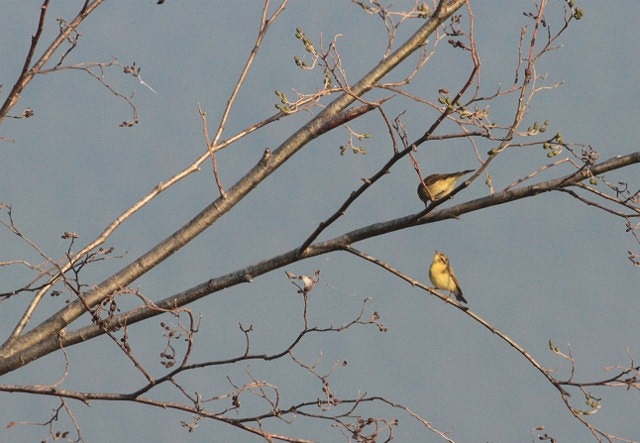 © nan
© nan
Switzerland
 © Mel
© Mel
 © BluTuna
© BluTuna
Garden in Johannesburg
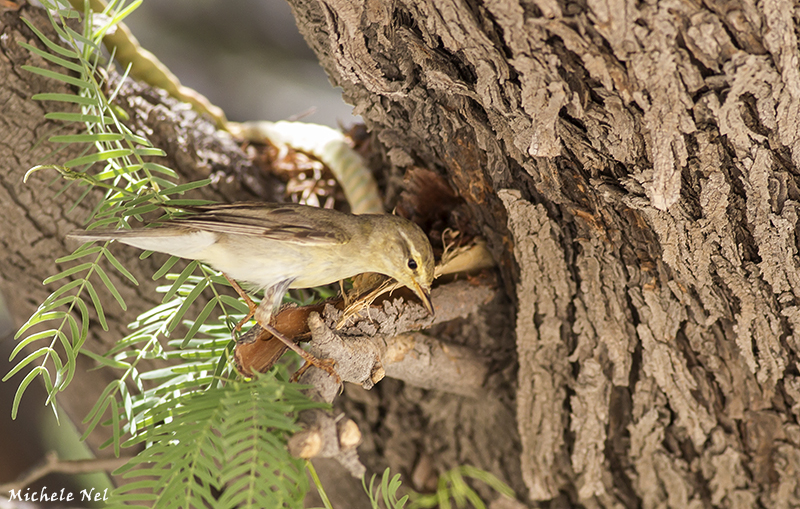 © Michele Nel
© Michele Nel
Kgalagadi Transfrontier Park, Nossob Camp - Jan 2016
Links:
Species text Sabap1
Sabap2
ARKive: http://www.arkive.org/willow-warbler/ph ... trochilus/
IDENTIFYING WARBLERS
 © nan
© nanSwitzerland
 © Mel
© Mel © BluTuna
© BluTunaGarden in Johannesburg
 © Michele Nel
© Michele NelKgalagadi Transfrontier Park, Nossob Camp - Jan 2016
Links:
Species text Sabap1
Sabap2
ARKive: http://www.arkive.org/willow-warbler/ph ... trochilus/
IDENTIFYING WARBLERS
Kgalagadi lover… for ever
https://safrounet.piwigo.com/
https://safrounet.piwigo.com/
Family Acrocephalidae (Reed/Marsh Warblers, Tree Warblers)
Acrocephalidae (the marsh or reed warblers and tree warblers or acrocephalid warblers) is a family of oscine passerine birds, in the superfamily Sylvioidea.
The species in this family are usually rather large "warblers". Most are rather plain olivaceous brown above with much yellow to beige below. They are usually found in open woodland, reedbeds or tall grass. The family occurs mostly in southern to western Eurasia and surroundings, but also ranging far into Pacific, with some species in Africa.
The Acrocephalus warblers are small, insectivorous passerine birds belonging to the genus Acrocephalus. Formerly in the paraphyletic Old World warbler assemblage, they are now separated as the namesake of the marsh and tree warbler family Acrocephalidae.
These are rather drab brownish warblers usually associated with marshes or other wetlands. Some are streaked, others plain. Many species are migratory. Many species have a flat head profile, which gives rise to the group's scientific name. Species breeding in temperate regions are strongly migratory.
Tree warblers are medium-sized warblers in the genera Iduna and Hippolais. They are found in Europe, Africa and western Asia. Until recently, they were all classified in the single genus Hippolais.
These warblers are associated with trees, though normally in fairly open woodland rather than tight plantations. Compared with the closely related Acrocephalus species, tree warblers have squarer tails and broader bill-bases. Most are unstreaked greenish or brownish above and cream or white below. They are insectivorous, but will occasionally take berries or seeds. The species breeding in temperate regions are mostly strongly migratory.
The species in this family are usually rather large "warblers". Most are rather plain olivaceous brown above with much yellow to beige below. They are usually found in open woodland, reedbeds or tall grass. The family occurs mostly in southern to western Eurasia and surroundings, but also ranging far into Pacific, with some species in Africa.
The Acrocephalus warblers are small, insectivorous passerine birds belonging to the genus Acrocephalus. Formerly in the paraphyletic Old World warbler assemblage, they are now separated as the namesake of the marsh and tree warbler family Acrocephalidae.
These are rather drab brownish warblers usually associated with marshes or other wetlands. Some are streaked, others plain. Many species are migratory. Many species have a flat head profile, which gives rise to the group's scientific name. Species breeding in temperate regions are strongly migratory.
Tree warblers are medium-sized warblers in the genera Iduna and Hippolais. They are found in Europe, Africa and western Asia. Until recently, they were all classified in the single genus Hippolais.
These warblers are associated with trees, though normally in fairly open woodland rather than tight plantations. Compared with the closely related Acrocephalus species, tree warblers have squarer tails and broader bill-bases. Most are unstreaked greenish or brownish above and cream or white below. They are insectivorous, but will occasionally take berries or seeds. The species breeding in temperate regions are mostly strongly migratory.
Family Acrocephalidae (Marsh Warblers, Tree Warblers) Index
Family Acrocephalidae (Marsh/Reed Warblers and Tree Warblers)
Acrocephalus griseldis Basra Reed Warbler 629
Acrocephalus rufescens Greater Swamp Warbler 636
Acrocephalus gracilirostris Lesser Swamp Warbler 635
Acrocephalus arundinaceus Great Reed Warbler 628
Acrocephalus schoenobaenus Sedge Warbler 634
Acrocephalus scirpaceus Eurasian Reed Warbler 630
Acrocephalus baeticatus African Reed Warbler 631
Acrocephalus palustris Marsh Warbler 633
Iduna natalensis African Yellow Warbler, Dark-capped Yellow Warbler 637
Hippolais olivetorum Olive-tree Warbler 626
Hippolais icterina Icterine Warbler 625
Acrocephalus griseldis Basra Reed Warbler 629
Acrocephalus rufescens Greater Swamp Warbler 636
Acrocephalus gracilirostris Lesser Swamp Warbler 635
Acrocephalus arundinaceus Great Reed Warbler 628
Acrocephalus schoenobaenus Sedge Warbler 634
Acrocephalus scirpaceus Eurasian Reed Warbler 630
Acrocephalus baeticatus African Reed Warbler 631
Acrocephalus palustris Marsh Warbler 633
Iduna natalensis African Yellow Warbler, Dark-capped Yellow Warbler 637
Hippolais olivetorum Olive-tree Warbler 626
Hippolais icterina Icterine Warbler 625
Lesser Swamp-warbler
635. Lesser Swamp-warbler (formerly known as Cape Reed Warbler) Acrocephalus gracilirostris (Kaapse Rietsanger)
Order: Passeriformes. Family: Acrocephalidae
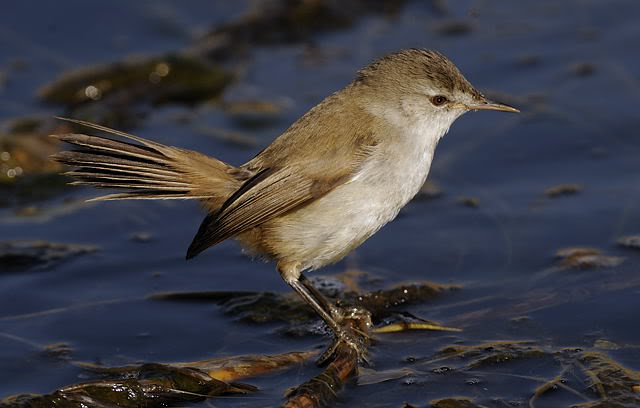
Description
14-16 cm long and weighing around 20 g. The long, strong bill has a slightly down-curved upper mandible; it is blackish-yellow with a yellower base. Iris is light brown. Legs and feet dark greenish horn or bluish horn, soles yellow. Upperparts are dark brown with rufous on fringes of feathers, the rump being dark brown with a richer rufous overlay. The tail feathers are dark chocolate brown edged rufous. The primaries are dark brown the secondaries are dark brown often edged buffish or rufous. The coverts vary from light to dark brown with lighter edges. Underwing coverts buffish. Head and neck greyish-brown or olive-brown, ear coverts light greyish-brown. Broad superdicium distinct whitish or light cream. Underparts are off white with rufous patch on flanks.
Similar species: It occurs alongside the larger Great Reed Warbler and Greater Swamp Warbler and overlaps widely with the much smaller African Reed Warbler and also with the similar-sized Little Rush Warbler. It appears more white underneath and has darker legsthan the other species of “reed” warblers. Told from Greater Swamp Warbler by warmly tinged upperparts and whiter (less greyish) underparts.
Greater Swamp Warbler has supercilium greyish, indistinct (not whitish, distinct) and underparts greyish (not whitish). Great Reed Warbler and Basra Reed Warbler larger and proportionally longer-winged.
Distribution
Most of the sub-region in suitable habitat, but absent from arid areas. Occurs from East Africa through Tanzania, Zambia and northern Mozambique to southern Africa.
Habitat
Wetland reedbeds, quite habitat specific, preferring reeds (Phragmites) and Bulrushes (Typha capensis) in lagoons, estuaries, marshes, rivers and man-made impoundments.
Diet
It does most of its foraging near the water surface, nimbly gleaning invertebrates from reed stems. It also takes food from the leaf litter and tree foliage on the banks of the water body, and it may even forage in the tree canopy.
Breeding
Monogamous and territorial. The nest is constructed solely by the female, who collects plant debris from the ground and rips off parts of reed stems. Using these she weaves together a neat, deep, cone-shaped cup, strung between 2-3 reed stems typically within 1m of the water surface. Egg-laying season is from August-May, peaking from October-February. It lays 2-3 brown eggs, which are incubated by both sexes for about 13-14 days. The chicks are fed by both adults, leaving the nest after about 10-14 days.
Call
A rich flutty cheerup-chee-trrrree song. Listen to bird Call.
Status
Locally common resident.
Order: Passeriformes. Family: Acrocephalidae

Description
14-16 cm long and weighing around 20 g. The long, strong bill has a slightly down-curved upper mandible; it is blackish-yellow with a yellower base. Iris is light brown. Legs and feet dark greenish horn or bluish horn, soles yellow. Upperparts are dark brown with rufous on fringes of feathers, the rump being dark brown with a richer rufous overlay. The tail feathers are dark chocolate brown edged rufous. The primaries are dark brown the secondaries are dark brown often edged buffish or rufous. The coverts vary from light to dark brown with lighter edges. Underwing coverts buffish. Head and neck greyish-brown or olive-brown, ear coverts light greyish-brown. Broad superdicium distinct whitish or light cream. Underparts are off white with rufous patch on flanks.
Similar species: It occurs alongside the larger Great Reed Warbler and Greater Swamp Warbler and overlaps widely with the much smaller African Reed Warbler and also with the similar-sized Little Rush Warbler. It appears more white underneath and has darker legsthan the other species of “reed” warblers. Told from Greater Swamp Warbler by warmly tinged upperparts and whiter (less greyish) underparts.
Greater Swamp Warbler has supercilium greyish, indistinct (not whitish, distinct) and underparts greyish (not whitish). Great Reed Warbler and Basra Reed Warbler larger and proportionally longer-winged.
Distribution
Most of the sub-region in suitable habitat, but absent from arid areas. Occurs from East Africa through Tanzania, Zambia and northern Mozambique to southern Africa.
Habitat
Wetland reedbeds, quite habitat specific, preferring reeds (Phragmites) and Bulrushes (Typha capensis) in lagoons, estuaries, marshes, rivers and man-made impoundments.
Diet
It does most of its foraging near the water surface, nimbly gleaning invertebrates from reed stems. It also takes food from the leaf litter and tree foliage on the banks of the water body, and it may even forage in the tree canopy.
Breeding
Monogamous and territorial. The nest is constructed solely by the female, who collects plant debris from the ground and rips off parts of reed stems. Using these she weaves together a neat, deep, cone-shaped cup, strung between 2-3 reed stems typically within 1m of the water surface. Egg-laying season is from August-May, peaking from October-February. It lays 2-3 brown eggs, which are incubated by both sexes for about 13-14 days. The chicks are fed by both adults, leaving the nest after about 10-14 days.
Call
A rich flutty cheerup-chee-trrrree song. Listen to bird Call.
Status
Locally common resident.
Dewi
What is the good of having a nice house without a decent planet to put it on? (H D Thoreau)
What is the good of having a nice house without a decent planet to put it on? (H D Thoreau)
Lesser Swamp-warbler Photos
635. Lesser Swamp-warbler Acrocephalus gracilirostris (Kaapse Rietsanger)
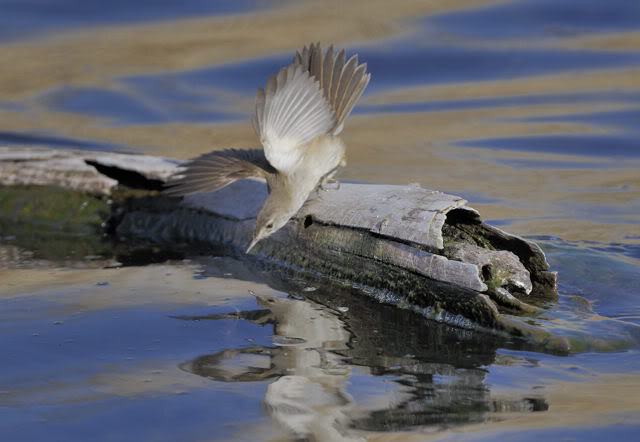 © Dewi
© Dewi
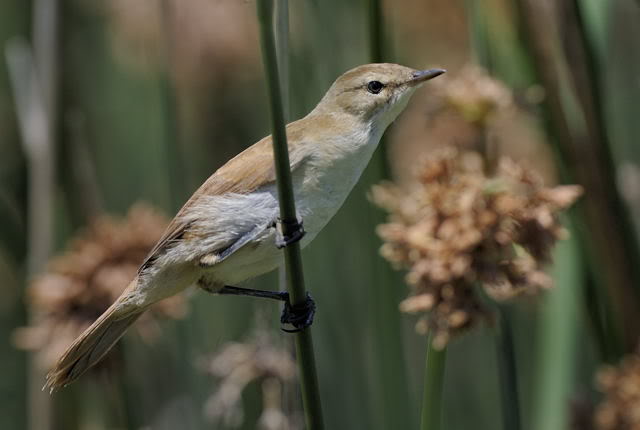 © Dewi
© Dewi
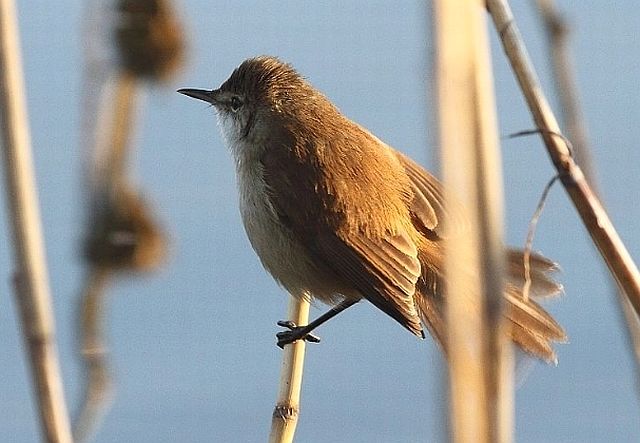 © Sharifa
© Sharifa
 © Sharifa
© Sharifa
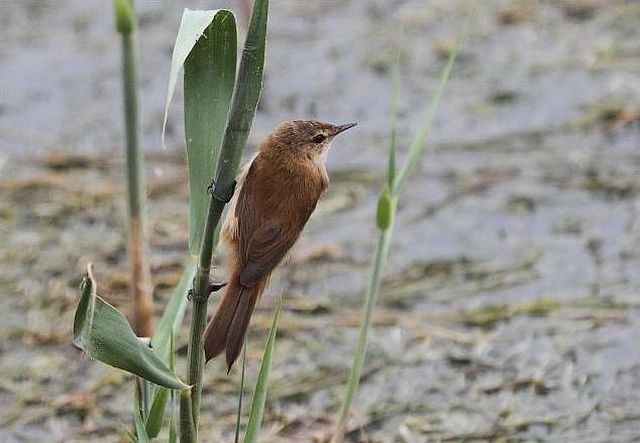 © Sharifa
© Sharifa
Garden Route National Park, Wilderness
Links:
http://sabap2.adu.org.za/docs/sabap1/635.pdf
http://sabap2.adu.org.za/spp_summary.ph ... §ion=3
IDENTIFYING WARBLERS
 © Dewi
© Dewi © Dewi
© Dewi © Sharifa
© Sharifa © Sharifa
© Sharifa © Sharifa
© SharifaGarden Route National Park, Wilderness
Links:
http://sabap2.adu.org.za/docs/sabap1/635.pdf
http://sabap2.adu.org.za/spp_summary.ph ... §ion=3
IDENTIFYING WARBLERS
Dewi
What is the good of having a nice house without a decent planet to put it on? (H D Thoreau)
What is the good of having a nice house without a decent planet to put it on? (H D Thoreau)
Great Reed-warbler
628. Great Reed-warbler Acrocephalus arundinaceus (Grootrietsanger)
Order: Passeriformes. Family: Acrocephalidae
Description
16-20 cm. A large robust reed warbler with brown upperparts and buffy-white underparts. Large billed. Legs brown/grey or pinkish-brown. Upperparts generally warm olive-brown, with crown slightly darker than mantle, rump and upper tail-coverts fawnier than back, and wing-coverts and inner flight-feathers slightly edged rufous. Face pattern with well-defined cream to buff supercilium from just behind bill to no more than half-way along ear-coverts, dusky eye-stripe, and brown lore and ear-coverts.
Juvenile has warmer coloration than adult and the underparts are washed buffy orange.
Similar species: Much larger than Eurasian Reed Warbler and has a longer, thicker bill. It resembles a large African Reed Warbler with a long, heavy bill and a well-defined pale eyebrow stripe. It is larger and darker than Basra Reed Warbler.
Distribution
It breeds across much of Eurasia and North Africa, flying south to sub-Saharan Africa in the non-breeding season.
Habitat
Reedbeds and waterside vegetation. In southern Africa it not only occurs reedbeds but also in other vegetation sometimes far from water, such as dense bush, gardens, sugar cane plantations. In arid areas it tends to only occupy wetland reedbeds, as the habitat away from the water is often to dry.
Movements and migrations
It leaves its breeding grounds around August-September, flying directly to sub-Saharan Africa. Most individuals arrive in southern Africa from November through to December, latecomers have been recorded in January. It often stays in the same area in consecutive non-breeding seasons, typically leaving this region from late February-March.
Diet
Insects.
Breeding
Nests colonially. Breeds mid March to mid June central and western Europe, early May in southern Europe. A suspended, basket-shaped nest at the edge of the reeds near the water. Nest site is dense stands of mostly reed in water. Preference for areas with thick reed stems. Nest attached to several stems. 3-6 eggs are laid, incubation 13-15 days, by female only.
Call
Loud, harsh grating, crackling and creaking notes, with frequent use of kar-kar-kar and kee-kee-kee. Listen to Bird Call.
Status
Common summer visitor to Northeastern South Africa, Mozambique, Zimbabwe, North & Eastern Botswana and Northern Namibia.
Order: Passeriformes. Family: Acrocephalidae
Description
16-20 cm. A large robust reed warbler with brown upperparts and buffy-white underparts. Large billed. Legs brown/grey or pinkish-brown. Upperparts generally warm olive-brown, with crown slightly darker than mantle, rump and upper tail-coverts fawnier than back, and wing-coverts and inner flight-feathers slightly edged rufous. Face pattern with well-defined cream to buff supercilium from just behind bill to no more than half-way along ear-coverts, dusky eye-stripe, and brown lore and ear-coverts.
Juvenile has warmer coloration than adult and the underparts are washed buffy orange.
Similar species: Much larger than Eurasian Reed Warbler and has a longer, thicker bill. It resembles a large African Reed Warbler with a long, heavy bill and a well-defined pale eyebrow stripe. It is larger and darker than Basra Reed Warbler.
Distribution
It breeds across much of Eurasia and North Africa, flying south to sub-Saharan Africa in the non-breeding season.
Habitat
Reedbeds and waterside vegetation. In southern Africa it not only occurs reedbeds but also in other vegetation sometimes far from water, such as dense bush, gardens, sugar cane plantations. In arid areas it tends to only occupy wetland reedbeds, as the habitat away from the water is often to dry.
Movements and migrations
It leaves its breeding grounds around August-September, flying directly to sub-Saharan Africa. Most individuals arrive in southern Africa from November through to December, latecomers have been recorded in January. It often stays in the same area in consecutive non-breeding seasons, typically leaving this region from late February-March.
Diet
Insects.
Breeding
Nests colonially. Breeds mid March to mid June central and western Europe, early May in southern Europe. A suspended, basket-shaped nest at the edge of the reeds near the water. Nest site is dense stands of mostly reed in water. Preference for areas with thick reed stems. Nest attached to several stems. 3-6 eggs are laid, incubation 13-15 days, by female only.
Call
Loud, harsh grating, crackling and creaking notes, with frequent use of kar-kar-kar and kee-kee-kee. Listen to Bird Call.
Status
Common summer visitor to Northeastern South Africa, Mozambique, Zimbabwe, North & Eastern Botswana and Northern Namibia.
Dewi
What is the good of having a nice house without a decent planet to put it on? (H D Thoreau)
What is the good of having a nice house without a decent planet to put it on? (H D Thoreau)
Great Reed-warbler Photos
628. Great Reed-warbler Acrocephalus arundinaceus (Grootrietsanger)
Order: Passeriformes. Family: Acrocephalidae
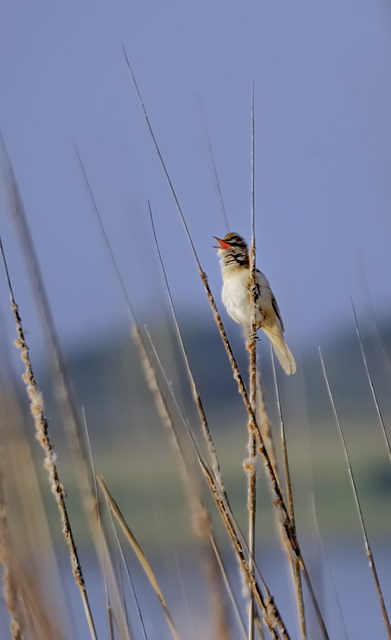
Links:
Species text Sabap1
Sabap2
IDENTIFYING WARBLERS
ARKive: http://www.arkive.org/great-reed-warble ... ndinaceus/
Order: Passeriformes. Family: Acrocephalidae

Links:
Species text Sabap1
Sabap2
IDENTIFYING WARBLERS
ARKive: http://www.arkive.org/great-reed-warble ... ndinaceus/
Dewi
What is the good of having a nice house without a decent planet to put it on? (H D Thoreau)
What is the good of having a nice house without a decent planet to put it on? (H D Thoreau)
Sedge Warbler
634. Sedge Warbler (formerly known as European Sedge Warbler) Acrocephalus schoenobaenus (Europese Vleisanger)
Order: Passeriformes. Family: Acrocephalidae
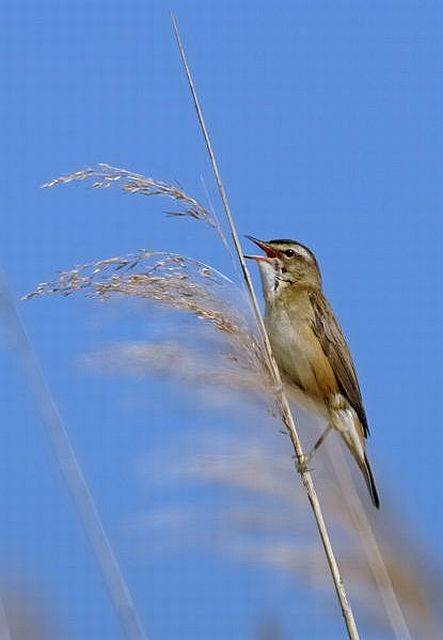 © Dewi
© Dewi
Description
A medium-sized warbler, 11.5-13 cm long and weighing around 12 g. The only streaked Acrocephalus warbler in the region. Streaked brown back and wings, pale underparts. Rump warm brown and unstreaked, contrasting with the duller wings. Longish, broad rounded tail. Forehead flattened, with prominent whitish supercilium, crown streaked with black, bill strong and pointed. Legs greyish. The plumage of the sexes is identical.
Juvenile birds have dark spots on the breast.
Distribution
Palearctic breeding migrant, with breeding grounds stretching from western Europe to Scandinavia to Siberia. In the non-breeding season it heads south to sub-Sarahan Africa, where it is widespread, occurring from Senegal to Ethiopia south to southern Africa. In southern Africa it is widespread and locally common near water, and consequently occurs more in the mesic north and east.
Habitat
Locally common in wetlands, especially well vegetated sewerage works. It generally stays in reedbeds, often including Papyrus (Cyperus papyrus) or weeds and trees at the waters edge. It is almost exclusively found near water (rivers, dams, vleis and sewage ponds), where it prefers short, annual swamp vegetation such as sedges, inundated grasses and tall weeds over or near the edge of the water.
Movements and migrations
Individuals gradually arrive in southern from late October-January, peaking around late November and December. Departure is more rapid, with most birds leaving from March-April.
Diet
It mainly preys upon slow-moving arthropods, gleaning them from vegetation, or occasionally from the ground or water surface. Before it migrates it often fattens up with midges.
Breeding
The nest, built by the female, is in vegetation on the ground or up to a height of 50 cm. The cup-shaped structure has an outer layer of grass, stems and leaves, plus spiders' webs, with a thick, finer layer inside including reed flowers, animal hair and plant down. It is woven around vertical plant stems. Between 3-5 greenish-yellow and brown-mottled eggs are laid, measuring 18x13mm and weighing 1.6 g each. They are incubated by the female for 14 days; the chicks are altricial and naked. Both male and female care for the chicks, which fledge after 13–14 days. After leaving the nest, young Sedge Warblers continue begging for food from their parents for between 1–2 weeks after learning to fly.
Call
Contact call sharp tuc. Song fast series of churring and warbling notes (including mimicry.) Listen to Bird Call.
Status
Common summer visitor.
Order: Passeriformes. Family: Acrocephalidae
 © Dewi
© DewiDescription
A medium-sized warbler, 11.5-13 cm long and weighing around 12 g. The only streaked Acrocephalus warbler in the region. Streaked brown back and wings, pale underparts. Rump warm brown and unstreaked, contrasting with the duller wings. Longish, broad rounded tail. Forehead flattened, with prominent whitish supercilium, crown streaked with black, bill strong and pointed. Legs greyish. The plumage of the sexes is identical.
Juvenile birds have dark spots on the breast.
Distribution
Palearctic breeding migrant, with breeding grounds stretching from western Europe to Scandinavia to Siberia. In the non-breeding season it heads south to sub-Sarahan Africa, where it is widespread, occurring from Senegal to Ethiopia south to southern Africa. In southern Africa it is widespread and locally common near water, and consequently occurs more in the mesic north and east.
Habitat
Locally common in wetlands, especially well vegetated sewerage works. It generally stays in reedbeds, often including Papyrus (Cyperus papyrus) or weeds and trees at the waters edge. It is almost exclusively found near water (rivers, dams, vleis and sewage ponds), where it prefers short, annual swamp vegetation such as sedges, inundated grasses and tall weeds over or near the edge of the water.
Movements and migrations
Individuals gradually arrive in southern from late October-January, peaking around late November and December. Departure is more rapid, with most birds leaving from March-April.
Diet
It mainly preys upon slow-moving arthropods, gleaning them from vegetation, or occasionally from the ground or water surface. Before it migrates it often fattens up with midges.
Breeding
The nest, built by the female, is in vegetation on the ground or up to a height of 50 cm. The cup-shaped structure has an outer layer of grass, stems and leaves, plus spiders' webs, with a thick, finer layer inside including reed flowers, animal hair and plant down. It is woven around vertical plant stems. Between 3-5 greenish-yellow and brown-mottled eggs are laid, measuring 18x13mm and weighing 1.6 g each. They are incubated by the female for 14 days; the chicks are altricial and naked. Both male and female care for the chicks, which fledge after 13–14 days. After leaving the nest, young Sedge Warblers continue begging for food from their parents for between 1–2 weeks after learning to fly.
Call
Contact call sharp tuc. Song fast series of churring and warbling notes (including mimicry.) Listen to Bird Call.
Status
Common summer visitor.
Sedge Warbler Photos
634. Sedge Warbler Acrocephalus schoenobaenus (Europese Vleisanger)
 © Dewi
© Dewi
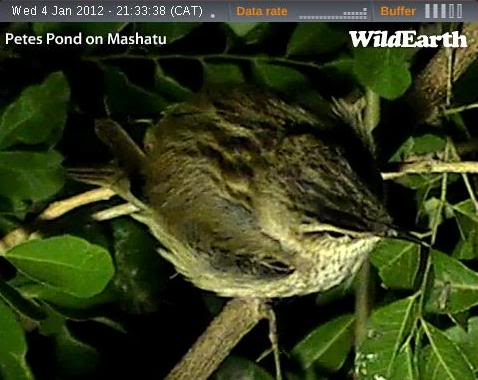
Links:
Species text Sabap1
Sabap2
IDENTIFYING WARBLERS
 © Dewi
© Dewi
Links:
Species text Sabap1
Sabap2
IDENTIFYING WARBLERS


